One of the things I read trying to learn about best approaches for running 100 miles (an ultramarathon) is that it’s mostly mental and logistical challenges rather than physical, because after a certain point everyone is running much farther than they’ve ever trained and what makes the difference is how well you deal with the mental and logistical challenges and problem solving when you reach those points. I took that to heart and did a lot of pre-planning for my 100 mile run attempt. You can read more about the other types of prep and decision making that went into this, but the below is a more tactical “here’s how I organized” the different things I had been thinking about for months.
Route Planning and Pace Chart
First, you either need to plan your route (self-organized) or get the course map (organized race). This enables you to start to build out a pace chart. I did this first, because it then informed fueling strategy, planning, etc.
I laid out my route (7 laps, which later turned into 8 planned laps based on re-designing my routes). I had a column for the distance of each lap/segment, then a total distance column. This was mostly to make sure I had my distance add up to > 100 miles; otherwise I don’t care about the rolling distance total. I then built out a pace sheet with what I thought my paces would be. I’m very slow and run/walk, and planned to go as slow as possible at the start to be able to finish the entire distance. So while normally my running might be 14:00-15:30 min/mile pacing, I expected to want to start around 16:00-16:30 min/mi pace and that I’d likely slow over time. As a result, I started my pace chart with a 16min/mi pace and did a 17, 18, 19, 20, and 21 min/mi pace chart for each of my segments. This enabled me to estimate the time it would take to run each lap (segment) at each given pace, and also a clock time that I would be expected to roughly finish that lap.

I also created a dynamic pacing chart that I could use to simulate different paces throughout my run. This enabled me to estimate what happens if I start fast and slow down a little or a lot and how that influences my overall time and pacing. During my run, my husband as crew updated the actual time to help estimate what my next segment time would be based on both the last segment time and overall pace. This helped him determine when he needed to set an alarm to come back out and meet me, as well as remind him where he was meeting me each time based on the route.
You’ll notice I’ve highlighted to make sure I remember to change the date when I cross over midnight, to make sure the pace chart updates accurately.
(Again, note these are simulated/fake times. The dark shading suggests when it’ll be dark, due to the time of year I’m running.)

Fuel, Enzyme, and Electrolyte Estimates
These pace charts were useful for then estimating what I’d need when. Namely, how much fuel I’d need to prepare in bags for my husband to give me for each lap. I used the slower paces for each segment and my plan of fueling every 30 min to determine how much I needed. For example, if I’m fueling every 30 minutes, my second segment is 13.06 miles and I’d probably be running around or below a 17 min/mi pace at that point, which means it’ll be 3.7 hours or so. This is 7 snacks (one every 30 minutes, and I’ll be back before the next snack time for my refill). But, if I run slower, I want to round up slightly and add a snack to that estimate, so I put in 8 needed for that lap. I did that for all laps, rounding to the next hour and/or adding 1 to the estimate.
I also estimated my electrolytes similarly. I drink water and get my sodium and electrolytes via a combination of my fuel and electrolyte pills, with taking electrolyte pills every 45 minutes. Again, I used the slower pace times and the segment time to determine how many electrolyte pills I needed for the segment and listed those out.
Then, you’ll notice I also estimated “enzyme” needs. I have exocrine pancreatic insufficiency, known as EPI, which means I have to swallow enzymes anytime I eat anything to help my body digest it. Fun, right? Especially when I’m eating every 30 minutes across a 100 mile run and how many enzymes I need to take depends on what I’m eating! I typically take two (one each of two types) over the counter enzymes for a snack; although some bigger snacks I can take 2-3. Therefore, I estimated one per snack plus a few snacks where I’d take the 2-3, and also factored in dropping a few (it happens). It adds up to ~118 enzymes but again, that’s a lot of extra added in so I don’t have to worry about running out if I drop some or eat bigger snacks. I calculated I’d probably end up consuming closer to ~80 of each type (so 160-ish total) across the 100 miles.
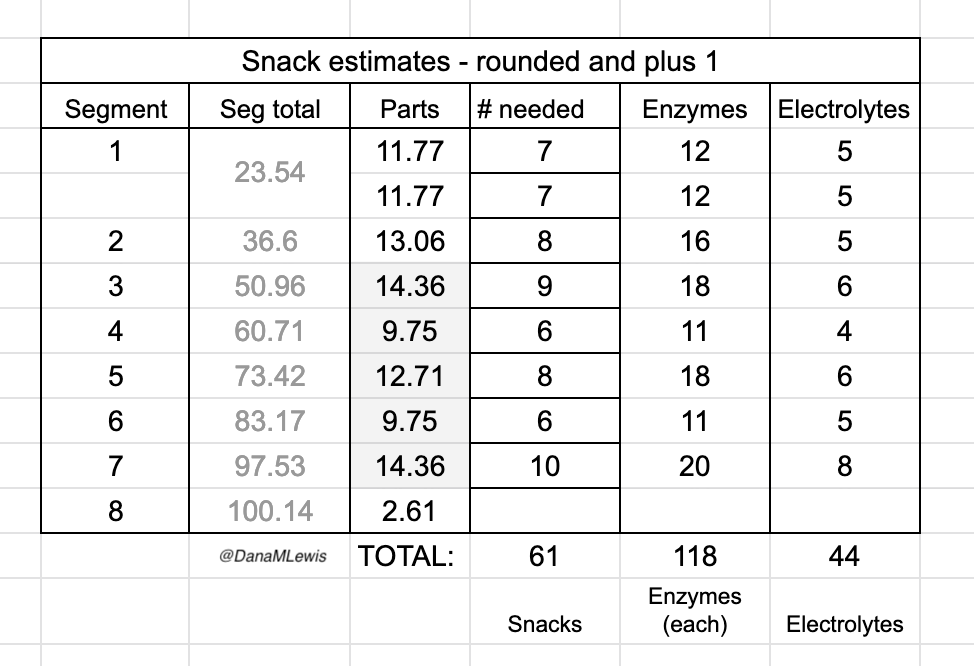
Deciding What I Want to Eat, When
Next, I took these snack per segment estimates and decided what I actually wanted to eat. Based on my training, I ruled out some foods and perfected my list of what I wanted to eat and had practiced.
I listed all my preferred snacks down a column, then listed out the laps/segments in the row at the top. I then started playing around with what I wanted to eat at different times. Knowing I’d probably get tired of chewing crunchy things (for me it’s not the chewing but the texture of the harder things in my mouth), I put things like my chili cheese Fritos and peanut butter pretzel nuggets toward the first few laps. Later laps got easier to chew/swallow items like peanut butter M&M, fruit snacks, etc.
At the bottom you’ll notice I have a few different columns. A lot of the snacks indicated with numbers are ones that are shelf-stable and pre-packed. Others are snacks that are at home in the fridge or freezer or require prep (like mashed potatoes). I have a variety of quantities of those prepared (see right side of table) so I can choose any combination of 2 of those for my husband to bring out each lap, in addition to the pre-packed shelf-stable snacks. The bottom combinations make sure I have enough snacks between the pre-packed snacks and 2 fresh snacks every time, based on the above chart I had made to estimate how many snacks I needed for each segment.
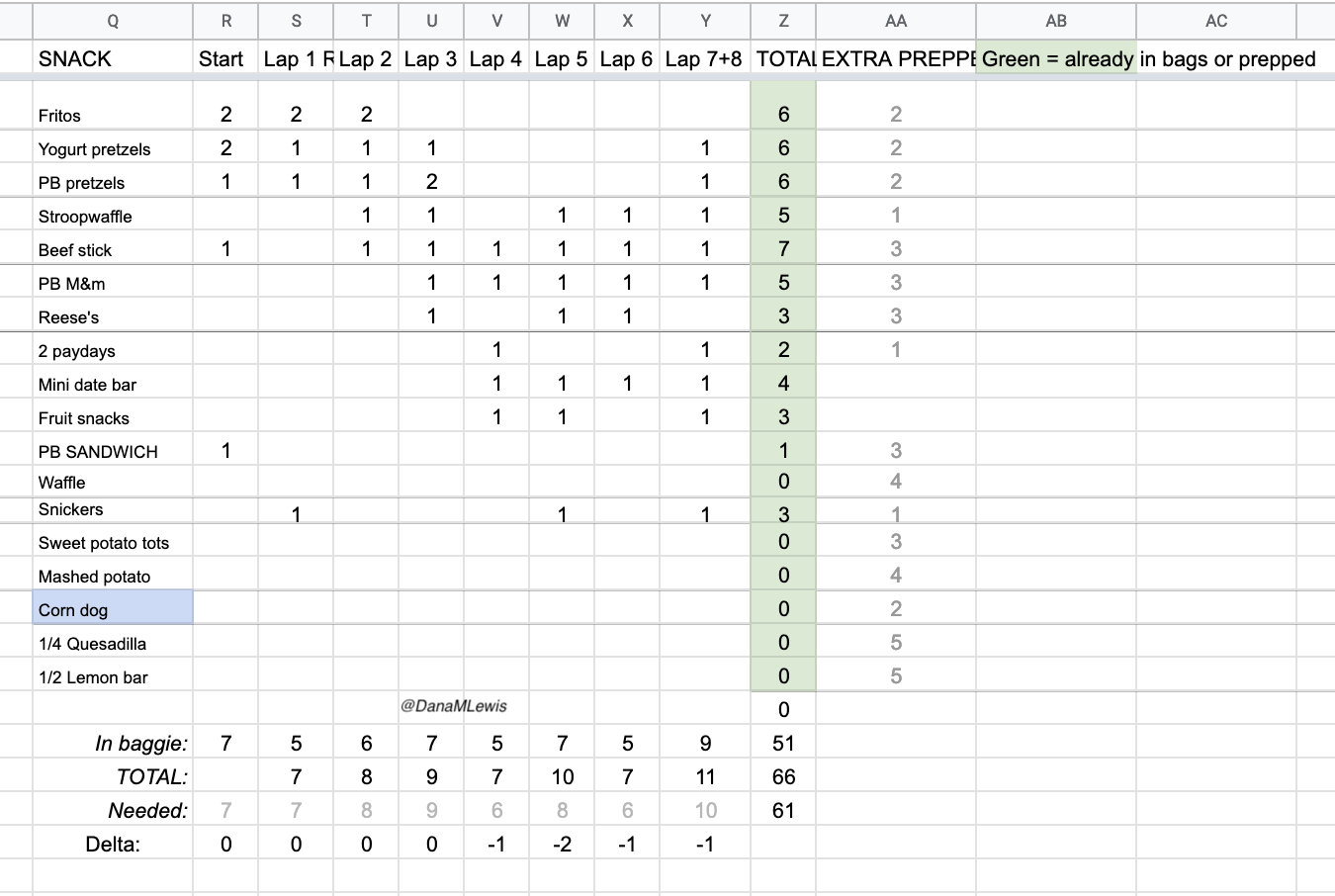
The other reason this chart is helpful is that I know how many extras of everything I have at home, too. So while I have certain amounts prepped and packed per column Z; column AA notes the extras I have pre-packaged and sitting at home, so if I get tired in lap 3 of beef sticks and want to not eat those, I can figure out what other 4 snacks I want that I have prepped and have my husband bring those alternatives.
One other note for nutrition and macronutrients: I use a macronutrient fueling tracking spreadsheet to help me track my calorie intake as well as sodium intake, to make sure I’m getting enough on a rolling basis. It also helps me figure out how many enzymes to take for each snack, if I don’t know it off hand or my brain forgets (as it might after running for 20+ hours!). You can read more about how I built and use this fueling spreadsheet here.
Planning Supplies
Over the last few months and especially the last training runs, I built a list/library of likely common issues I experienced or had learned about by reading other people’s race recaps and reports that I wanted to be prepared for. I organized it by type of problem, then listed potential supplies and solutions. For example, I had a blisters/feet section; low sodium; high or low blood glucose (because I have type 1 diabetes); etc.
The solutions list here is unique to me/how I solve things, but here’s an example of what I would include:
- Sodium
- More electrolyte pills more frequently than 45 min
- Short term fix: Chicken broth (¼ is 530mg sodium. Entire thing is 2120mg)
- Less sodium but variety: GZero (no carb) gatorade sips – whole bottle 270mg
I then also started a separate document for 100M Prep. This included a long checklist of all the items I had brainstormed as solutions – so in the above sodium example, it included extra electrolyte pills; chicken broth; Gatorade Zero; etc.

This became helpful for me to a) make sure I had these things at home and to get them if I didn’t have them yet and b) to make sure I had set them out/organized them prior to my run so they’d be easily accessible for my husband to find.
The 100M Prep document also helped me break down larger tasks, too. Instead of “blister kit”, I started a sub-list that described everything I wanted in that baggie.
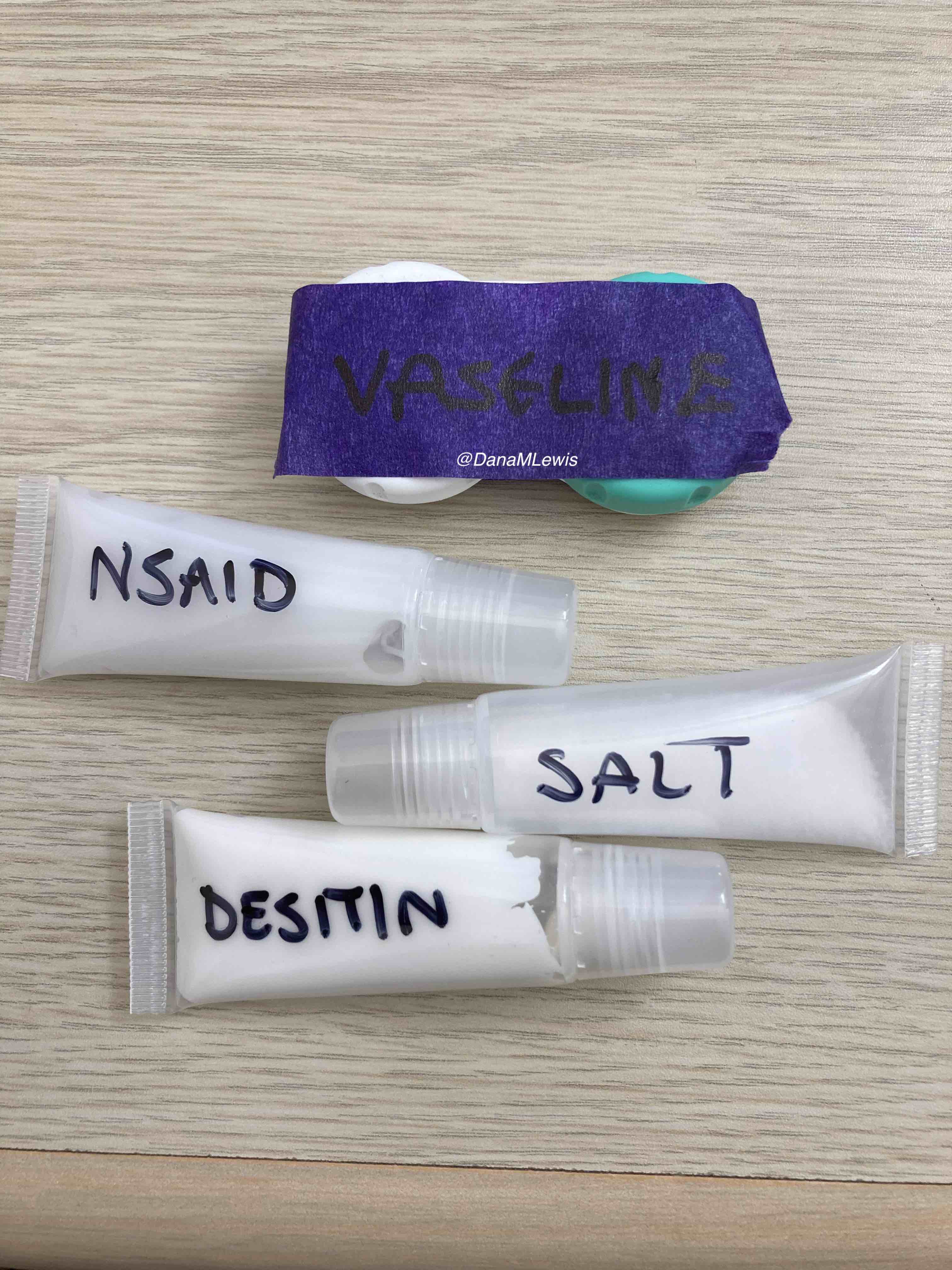
This also helped me realize when I needed to add a task for splitting supplies. For example, if I had a big tube of cream or ointment that I possibly wanted to be in two places (such as a certain type of foot lubricant). I had previously bought a bag of empty lip gloss tubes for making travel size toiletries (shampoo, face wash, etc.). I realized that they also worked great for liquid, gel, cream supplies for ultra running, too. And so I added tasks for splitting those into smaller tubes once I decided and listed where they should go and thus how many I needed.
I also had a checklist for each lap bag, which is a combination of which snacks (planned above) and other supplies (like eye drops) that I wanted to have each time. I made a checklist for each lap, then laid out all my supplies and checked them off the list for each lap. Once I had all the supplies laid out, I then compiled them into one bag for each lap and added a label. This way my husband has one bag to bring for each lap, and there is a sticky note on top of each bag that has anything else (e.g. 2 fresh food items from home) he needs to add and bring that lap.

(Again, this is planned food, electrolytes, and enzymes for each lap. See the above section to see how I estimated the food/snacks, electrolytes, and enzyme needs.)
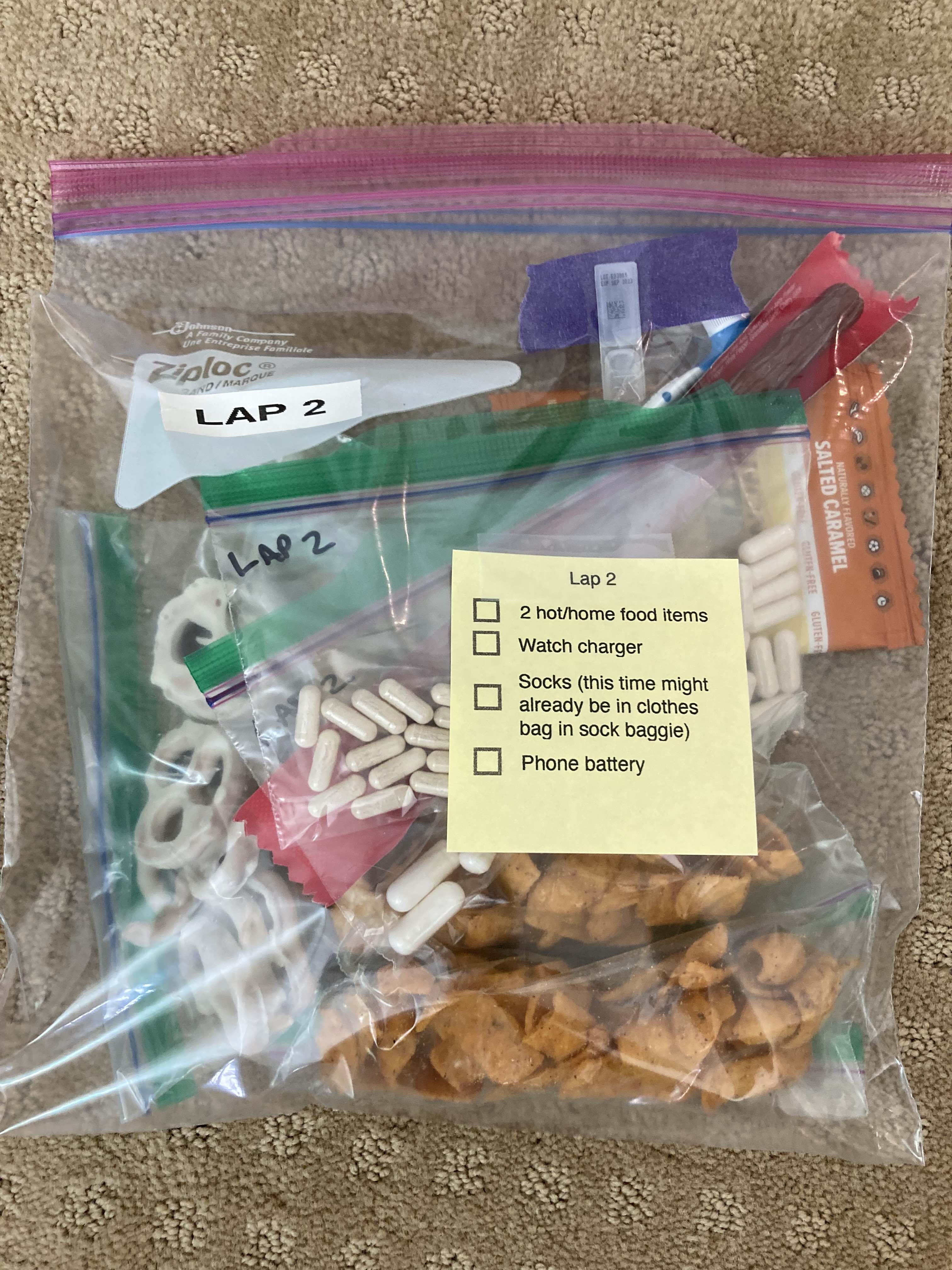
I had started a list in a PDF for each lap, then printed the list for each lap on a sticky note so I could easily tape it to the bag and it would be easy for my husband to read.
Editor/Husband/Crew note from Scott: “These pre-prepped lap bags and printed sticky notes turned out to be most useful for making sure I got everything prepped each time. When I got home after each pit stop, I would pull out the next lap bag and make sure I had everything charging/washing/drying that I’d need at the next pit stop. Then when it got close to time to go, I’d work down the checklist, collecting each thing and putting it in my bike’s saddlebags, and then put the lap bag on top when I had everything packed.”
Crew Checklist
The same document as the overall solutions list became my Crew Checklist document. I added a checklist for what we should be doing at each lap. Again, this is unique to me, but it included things like putting my watch on the charger; removing trash from my vest; replacing water and ice in my hydration pack; replacing my battery for charging my phone; putting my fuel/enzymes/electrolytes into my vest and using eye drops; swapping socks; seeing if I need replacement supplies for low blood glucose; and after midnight considering whether I wanted to drink a Diet Mtn Dew for joy and caffeine.
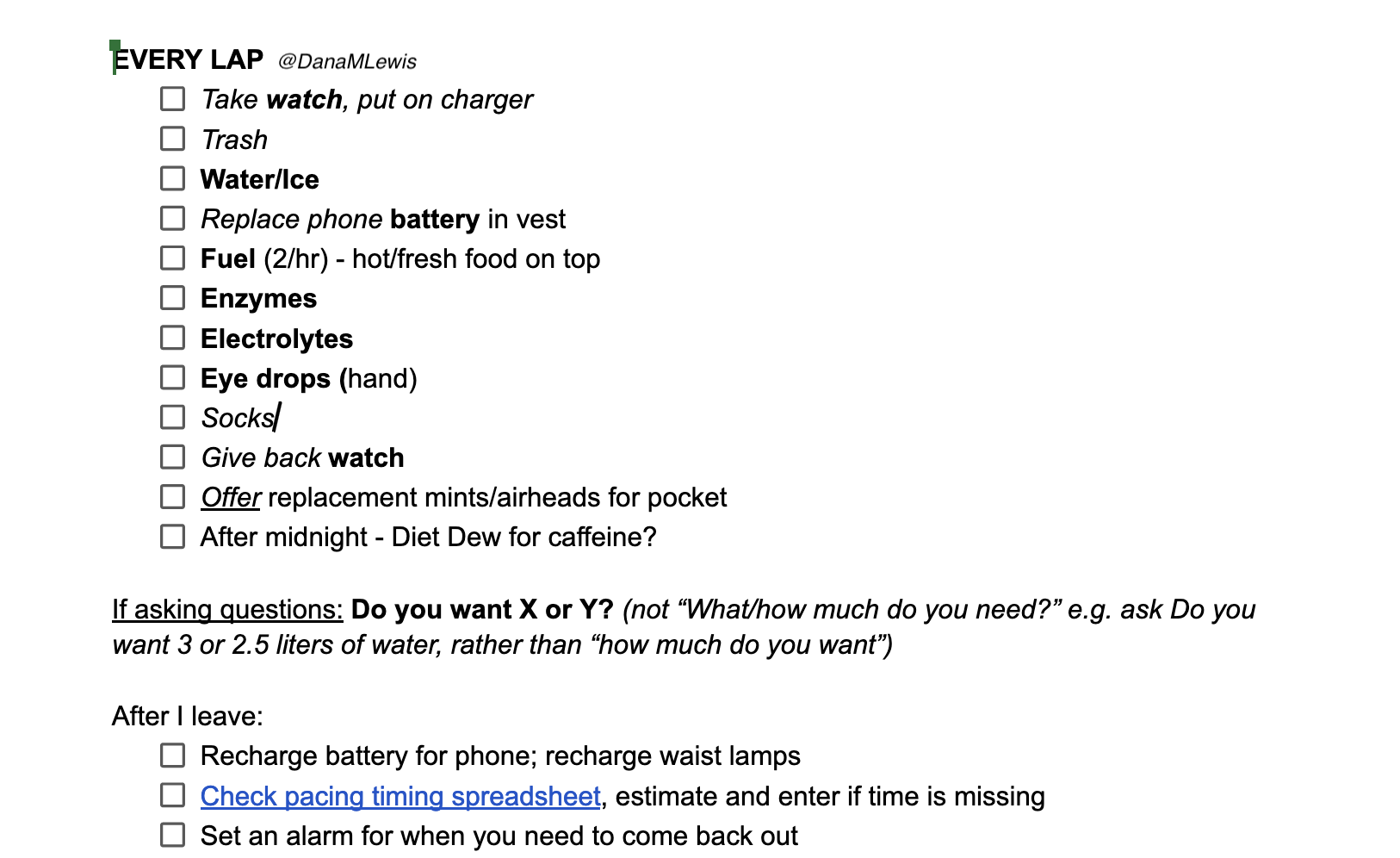
You’ll also spot the section I added for my husband for after he gets home to remember to charge batteries on various things, use the pacing spreadsheet to help him figure out when to come back out, etc.
At the bottom of my crew document (the lap checklist is at the top, followed by the comprehensive solutions list), I also included an example pep talk section with constructive things to say. If there’s things you don’t want your crew to say (e.g. “you’re almost there!” or “only X hours left” are on my ‘please no’ list), you can also list those out. I also have my list of run-ending situations that my husband and I agreed upon, which includes things like having a broken bone; severe dehydration or peeing blood; hypothermia; etc.
And finally in the document at the very bottom, I created a checklist for post-race care so when I get home and everything feels terrible and I don’t know what to do, my husband has my pre-thought-of checklist of things in the best order (shower then compression sleeves; making sure I eat something within an hour of finishing; etc) to help me do all the self-care things I’m probably going to forget about.
Editor/Husband/Crew note from Scott: “Peace-time plans are of no particular value, but peace-time planning is indispensable” and “No plan of operations extends with any certainty beyond the first encounter with the main enemy forces.”
– This particular document ended most useful for pre-race planning purposes, including our night-before review of all the plans. I glanced at it a couple times during the race, but mostly relied on the lap-bag checklist and the physical presence of items in my saddlebags at the pit stops.
DanaWatch
The other thing I had prepared was a document with instructions for friends who had agreed to help out during the overnight hours for me. My husband was “on call” and crewing the whole time, but overnight there were sections where I was out running 3-4 hours and he needed those times to sleep. For those hours, we set up “DanaWatch” (as I call it), with a friend who will text me every half hour or so to check on me. If they don’t get a text back (a simple emoji or other text from my watch), they were to call me, and if they couldn’t reach me, they’d call Scott. So, the document has these instructions, an outline of my safety plan, Scott’s number, etc. so everyone knows what the plan is. I had friends staggered over different times. For example, a friend in the UK was to text me starting around 8am his time, which is midnight for me. When another friend wakes up on the east coast (three hours ahead of me), she’d starting texting me, and so on. This way I wouldn’t feel “alone” and would have extra folks watching out to make sure I’m still on track.
—
I think that’s everything I did to prep in advance! Mainly, having those documents built to add ideas to (especially problems and troubleshooting solutions) and building out my pace chart so I could progressively make my fuel, electrolyte, enzyme and supply plans in advance was really helpful. Then I blocked off time the week before my run to make sure I had everything prepped and ready to go well before the day before my race, so I wasn’t stressed about getting ready. As I described in my other preparation for ultra post, anything I could do to limit stress and mitigate decision-making fatigue, I did. And it definitely helped!

All of your posts for ultrarunning have been extremely helpful, since I will be running my first 100k and am concerned about 2 autoimmune disorders and managing it all while running long distances.
Thank you for all of your great organization and spreadsheets.
Thanks so much for the comment Susan – I’m so glad this is helpful to someone else!
Kudos for taking on 100k – let me know if you discover any other tips as you prepare that were helpful!
Your articles are great. Do you have these organizational templates/tools available for purchase? I love the pace chart and the crew checklist examples
Thanks! No, I don’t have anything for purchase, but if it’s of interest I’d be happy to share a copy. Shoot me an email (Dana@OpenAPS.org) and let me know which ones you’d like (or put in the screenshot) and I’d be happy to make a copy for you. To be honest, there are probably better pacing chart templates out there but happy to share mine as an example regardless!